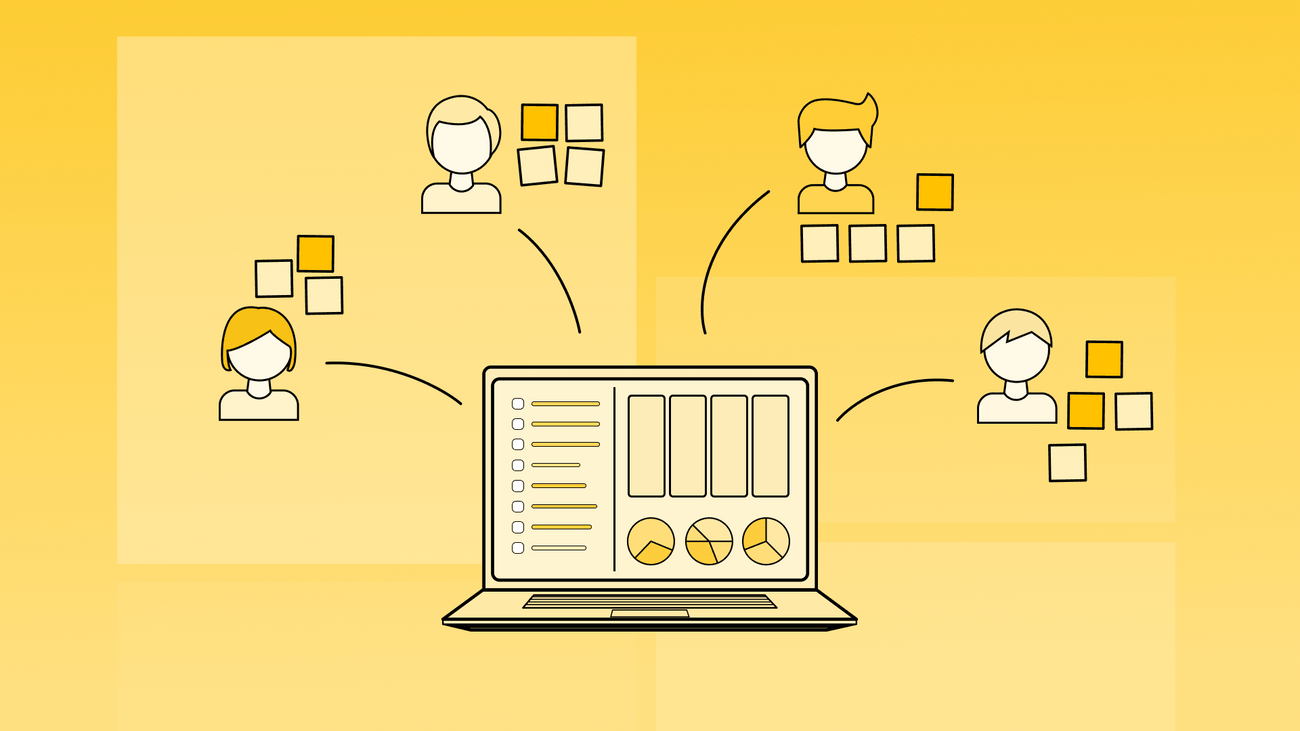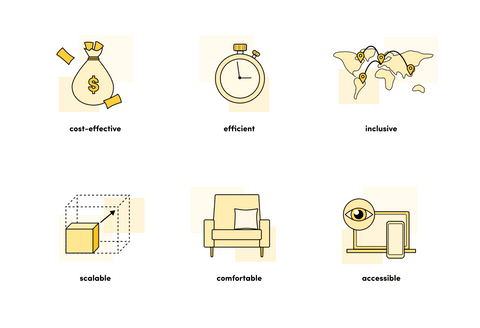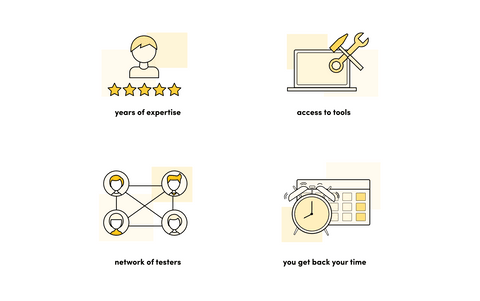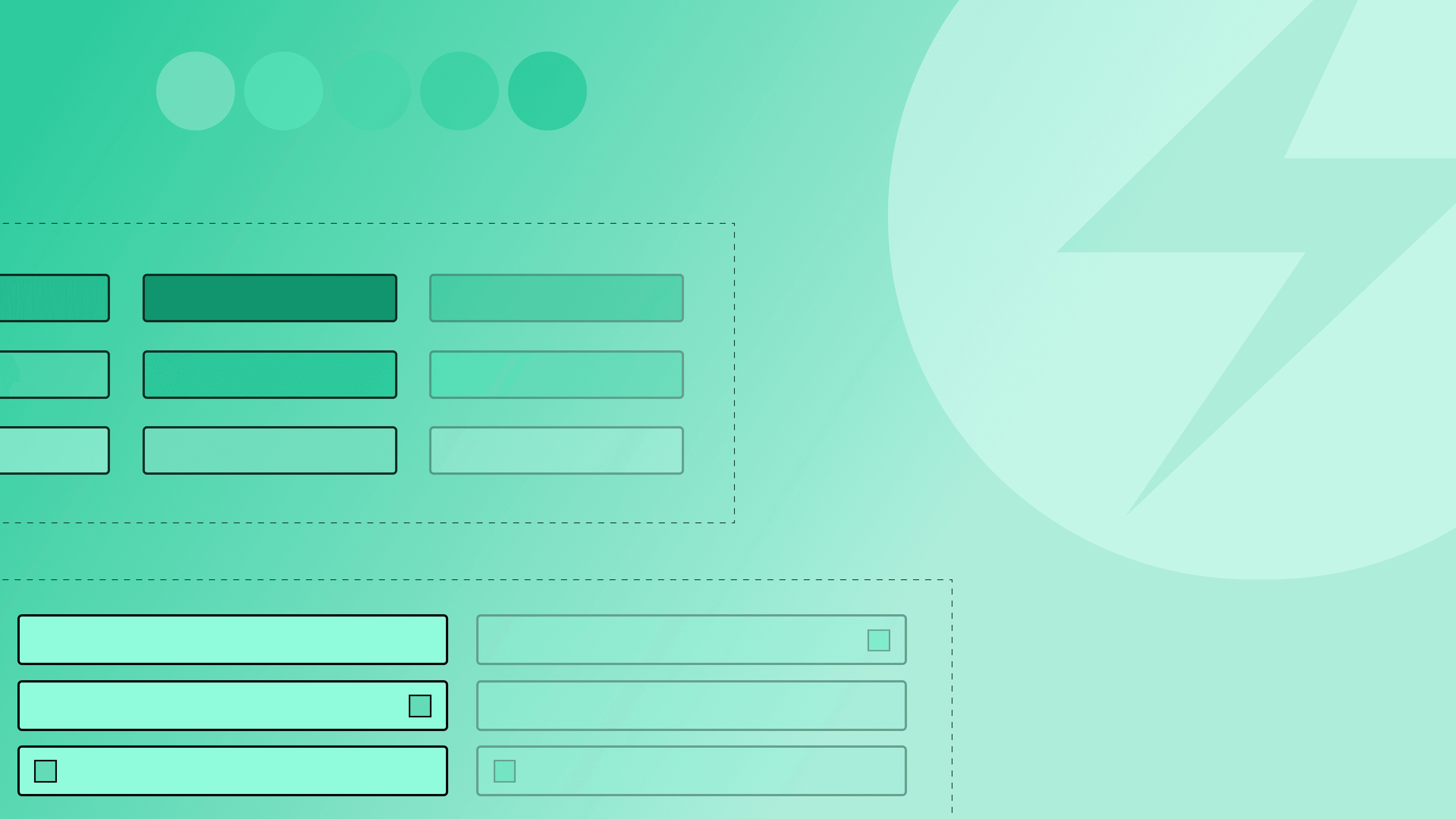

Blog

Remote user research – as early and as often as possible
In this article we’ll take a look at what remote user research is, how it differs from regular user research, how it can benefit (or doom) your project, what methods and tools to use for remote research, and above all… why you don’t really need to worry about all that at all!
It seems like there is a new mobile application launching in app stores every minute. And one new SaaS platform launching every week. In a market filled to the brim with new solutions for every possible problem imaginable, how do you ensure yours isn’t a failure? Not to mention an even bigger question: how do you stand out?
That’s surprisingly easy. You simply listen to your customers. If you do it well, they will tell you exactly what they need and what you’re missing.
While this answer is brilliantly simple, it’s much harder to execute. How do I collect feedback? When should I do it? What will I need? So many questions. And again, one solution: remote user research.
Introducing remote user research
But let’s start at the beginning. What is user research in general? In layman’s terms, user research – also called “user experience research” – is a practice of collecting information about what the users think about your product and how they interact with it in order to make it better.
This can be done through a battery of experiments, ranging from simple user interviews to usability testing, and beyond. Remote research is the same thing, except it’s done online.
Well, I say it’s the same thing because the effects you want to achieve are the same whether you do research remotely or on-site. You want to learn what pains the users and how you can alleviate that pain. The method, however, will vary.


There used to be a time (pre-2020, if you know what I mean) where remote methods were considered to be “the ugly stepsister,” an inferior way of doing user experience research. I’m here to tell you remote research is not worse, it’s just different.
Yes, it does have it’s drawbacks, but it also has some incredible benefits – both of which we’ll discuss later. In some cases it’s actually the better choice. One could argue that software development is one of these cases.
User research methods
Before we dig in a little deeper into how to conduct remote research, let’s first discuss what types of user research there are (apart from, obviously, remote and on-site) and why it’s important to distinguish between them.
Explore or evaluate?
What research method you choose largely depends on the stage of your project. This is why it’s helpful to distinguish between exploratory (or generative) and evaluative research.
When you are only designing your product, you’ll be doing exploratory research. This means you’ll be looking into how to best solve a problem people have, so that you can later design a perfect product that answers user needs.
When you already have a product, you do evaluative research. It helps you gauge how good your product is at what it’s supposed to do and hopefully tells you how to improve it.
Quant or qual?
What type of data you want to collect will determine if you conduct quantitative or qualitative research.
Quantitative research is where you collect a large volume of data points to arrive at a conclusion. For example, you may run A/B tests on your landing page. You’ll design two variants and display them randomly to an qual number of people (so, say, 500 see design A and 500 see design B). Then you evaluate which design was more effective at achieving your predetermined goal (e.g. which one drove more conversions).
Qualitative research is when you take a smaller sample, but ask open-ended questions that provide you with deeper insights, like in the case of conducting in-depth interviews (IDI). There, you may show your design to 10 people and ask them what they think about it. This will hopefully allow you not only to evaluate if they liked it, but also what’s the rationale behind their preferences.
Now or later?
An important thing to distinguish is the difference between synchronous (moderated) and asynchronous (unmoderated) research.
With the former, you’re simply there at the same time your study participants are – think user interviews.
With the latter, the participants perform the tasks in their own time and your assistance isn’t really required (unless they run into some trouble) – think surveys.
Whether you should go with moderated or unmoderated study largely depends on what tests you decided to go with.
Stages of user research
Broadly speaking, you could say there are 4 steps you need to take to conduct user research in general.
While this remains unchanged whether you do it online or on-site, there are some considerations you need to take into account when doing remote research. Let’s go through each stage.
Preparation
Before you start interviewing people and running all sorts of tests, you need to do some prep work. Namely, you have to ask yourself three questions:
- What do I want to achieve? (what question do I need answered?)
It’s very important to pose the right research question. Otherwise, your results will always be inconclusive. How does a good research question look like? It’s focused and specific, so that you know what factors into the results. At the same time, it must be complex enough to give you insights that you can generalize and apply more broadly. - Who should I interview? (who are the people that can answer my question?)
It’s probably not a good strategy to go around the office asking what people think of your idea. More likely than not, they are not your target, and most definitely they are not objective. So identify who’s your customer (aka user persona) and where to find them. - How to conduct my research? (how best to get the answer I need?)
Now that you have an idea of whom and what you want to ask, you need to figure out how. The research method – as we’ve already discussed – will depend on the goal you have in mind, the maturity of your project, and also on who the users are.
You’d be wise not to skip these questions, as they will determine the success of your entire research. To put it bluntly: if you do your prep wrong now, you’ll just sink a lot of money into nothing later.
Recruitment
Now is the time to find the right people for your study. Since you already know who you want to interview, how, and about what, this seems like an easy task. But oftentimes, it is actually not.
For one thing, people don’t necessarily like to give out their time to participate in tests for companies they don’t know for nothing in return. But even if you offer some form of a reward, you might be hard pressed to find the right study group among your connections.
This is where remote research gets ahead. Because you don’t have to consider constraints such as distance or time, it’s much easier to find participants for your study. It also gives you more variety, as you can interview people from different cultures. This effectively ensures your research is more inclusive and thus objective.
It is worth mentioning that sometimes you don’t even need to recruit participants in the traditional sense, particularly for quantitative studies. If you have an already functioning product, such as a web platform, you might collect anonymous data about its usage. Tools such as Hotjar are a great way to gather insights on how users navigate your software without having to actually enroll them in a study.
Collecting data
Once you have your participants, you’re ready to collect data. That’s another point where you might notice the benefits of conducting remote research.
Nowadays there are plenty of remote research tools that practically do the work for you, freeing you to focus entirely on asking the right questions.
In a pinch, there’s also general-purpose software (such as Google Workspace) that you can use for your research if you’re willing to make some sacrifices. For an overview of some useful tools, read on!
Analysis
Onto the last stage! Now that you did all that hard work collecting the data, it’s time for an even harder job: figuring out what it means. Thankfully, if you asked yourself the right questions in the prep stage, all pieces should fall into place and you should get the answers you need.
Remote user research tools
I promised you an overview of some remote tools that you might use for your research. Obviously, the choice will vary significantly, depending on your remote research methods.
For example, in a quantitative study you will probably want to conduct some workshops. So, you’ll be interested in collaborative tools that allow you to simulate workshop conditions online, like virtual whiteboards. Meanwhile, for a quantitative study, you’ll naturally be interested in tools for data collection and analysis.
Here are some remote user research tools that we like at Gorrion, divided into their respective categories. Mind you, some of these platforms have multiple uses, so they may fit into more than one category.
Tools for quantitative studies
- Google Analytics – of course, it’s the number one platform to measure your website traffic and flows
- Hotjar – that’s another legendary tool that helps you analyse what people do around your website
- Heap – helps you analyse user journeys by capturing their interactions (such as clicks)
- Maze – a platform for continuous product discovery using a variety of unmoderated tools
- Userzoom – another tool for unmoderated user research
- Typeform – a flexible tool for creating easy-to-understand forms and questionnaires
Tools for qualitative studies
- dscout – a platform that connects you to vetted study participants
- UserTesting – another platform to recruit participants for remote user testing
- Otter – a speech-to-text transcription platform that frees you from taking notes
- Useberry – platform to get remote user feedback before development stage
- LookBack – helps you conduct dedicated research video interviews easier
- Reframer – a tool that makes it easier to analyse your qualitative research
Why you need remote user research
In case it’s not already patently obvious, you need to apply one user research method or other to know what you’re doing. Has it ever happened to you that you were absolutely sure everyone does something the way you do, only to find out they don’t? It certainly did to me when I found out people pour their cereal in the bowl first, and follow up with milk.
On a more serious note, user experience research has taught us time and time again that people don’t necessarily use software the way developers intended them to. And the only way to solve that problem is to be user-centric, go with the flow, and make the experience easier for the user.
There is an even bigger pitfall when you haven’t even developed your product yet. In that case, conducting research helps you answer an even more important question: does anyone even need it?
I’m sure all the start-up owners who developed their product because they grew frustrated with [insert the name of a leading industry platform] were, in fact, very frustrated with the platform. But are other users frustrated with it enough to go looking for a new one and then go through the entire painful process of purchasing, migration, and onboarding? Or is that bug that stings them actually a feature for others?
These are the questions that need to be answered because they can make or break a product (and an entire company). Applying the correct research methods can help answer them.
Benefits of remote research
Even though some may turn their nose at remote research methods as inferior, there are actually a lot of benefits to it. These include:
- cost effectiveness – because it doesn’t require things like extensive travel or physical set-up, remote research usually turns out to be less expensive;
- efficiency – again, since you don’t need to move around, you save more time and you can be more flexible with it, interviewing users from different parts of the world at the same time;
- extensiveness – remote research gives you access to users from different parts of the world, which improves the quality of your data and makes your study more inclusive and accurate;
- scalability – for the reasons listed above, you can interview a whole lot more people than if you were to meet with them face-to-face. Also, digital tools help you collect data way more efficiently than traditional methods would;
- comfort – for many study participants it’s much better to be involved from the comfort of their home, without having to waste time on commuting;
- involvement – because in remote research everything is digitized, it’s much more democratic, as it is easier for you to involve different departments (R&D, product, designers, marketing etc.) to both provide their input and draw their conclusions;
- accessibility – let’s face it, for digital products it’s only natural that you present them to the users digitally, so remote UX research becomes an obvious choice.
Drawbacks of remote research
Having said that, there are some pitfalls to remote research that you should pay attention to and mitigate. These are:
- data breaches – naturally, you may be anxious to share a proprietary product that hasn’t been shipped yet in an uncontrolled environment. This is why it’s especially important to sign proper non-disclosure agreements and ensure security of all the data;
- technical issues – since remote UX research is so dependent on technology, it follows that sometimes technical issues will occur. Before you share anything with participants, you should first test it internally to smooth out all the wrinkles and then always be on hand to help if anything goes wrong;
- less direct communication – since there is always something between you and the participant, the interview may feel a bit impersonal and it may be more difficult for them to open up. Remote research methods require more time and effort to create a real connection with the user that will ensure quality feedback;
- contextual limitations – let’s face it, not all products can be tested remotely, either due to their nature or because of their users (let’s say if you’re testing anything for babies, you probably would prefer to see their reactions directly, rather than interview them online). Take time to analyse what will work best for your product and act accordingly.
Why you don’t need to do it all
Here’s the kicker: you don’t actually need to do user research – remote or onsite. That is, you don’t need to do it yourself.
Considering how involving it is, if you are developing a digital product, it might actually be better for you to outsource it to someone – like a software development agency – rather than do it yourself. Especially if you don’t have the experience.
Reasons for outsourcing
- They have the expertise. Contrary to what some may believe, software development agencies don’t only write code. User experience research is an integral part of product development that these companies are very familiar with, having done hundreds of studies before. They know how to structure, conduct, and evaluate research, so you can rest easy.
- They have the tools. Building your own stack for remote user research may prove not only expensive, but also time consuming. After all, there are so many solutions out there, even researching the research tools can take weeks. Meanwhile, software houses have their tried and tested tools that you won’t need to pay for!
- They know people. If you’re having trouble finding the right people for your study, here’s the answer! An agency may already have a database of previous participants or a pool of connections they can use for your research.
- They’ll do the work for you. Let’s face it: user experience research, remote or not, is necessary but time-consuming. Do you really want your team to spend all that time tangled up in it, or could their experience be better used elsewhere? Ultimately, outsourcing it may prove both faster and cost-effective.
You’re not alone
I hope this article convinced you that you need user research to develop a successful product. And that remote user research is a valid alternative that has many benefits. Among others, these are time and cost savings, flexibility, and convenience.
This is why when people ask us if and when they should do UX research, we tell them: as early and as often possible.
Remember that if any of this seems overwhelming, you don’t have to do it yourself! There are professionals that you can turn to for help. If you want, you can always hop on a call with Gorrion, and we’ll guide you step by step through the process!


Have a project in mind?
Let’s meet - book a free consultation and we’ll get back to you within 24 hrs.





